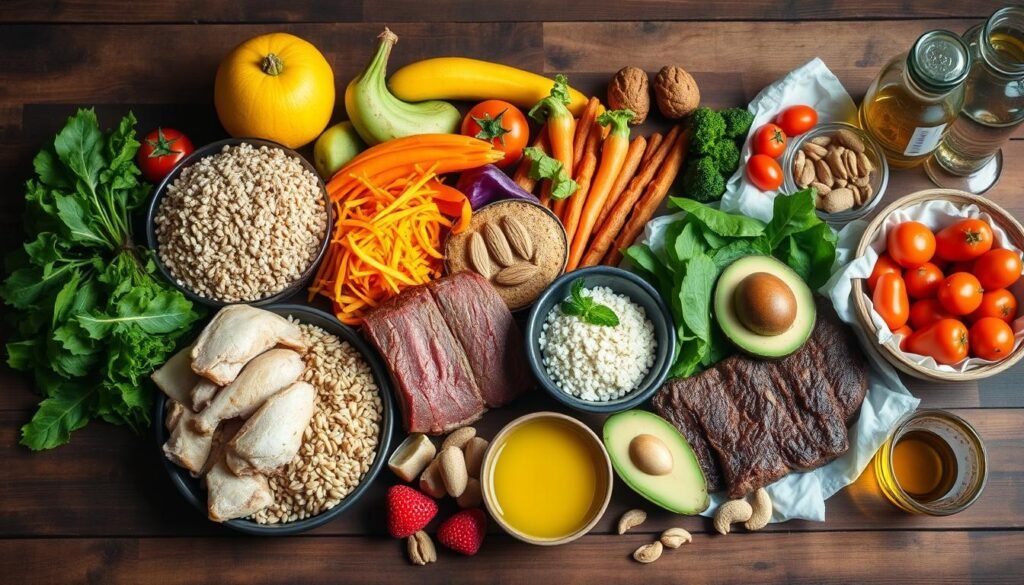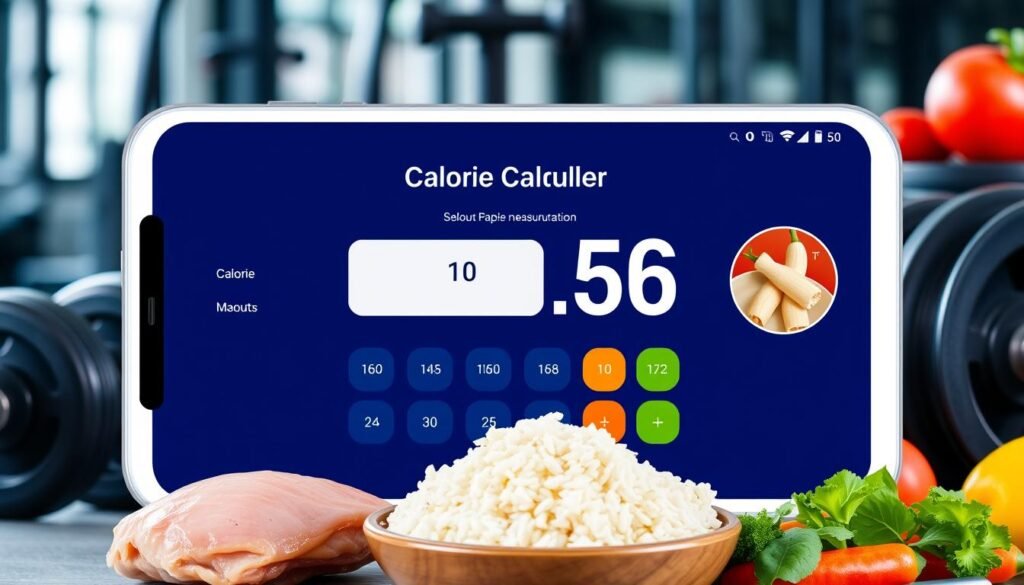Did you know you need about 500 extra calories a day to bulk up properly? This extra energy helps add muscle while keeping fat low. Bulking is more than just eating extra food. It requires careful calorie tracking to focus on muscle growth, not fat. A calorie calculator for bulking makes diet planning easier. It lets you adjust your food based on your own body and goals. We’ll explain the importance of bulking and how to use these calculators for the best results.
Key Takeaways
- Bulking requires a caloric surplus of about 500 calories for effective muscle growth.
- A calorie calculator for bulking aids in customizing dietary needs based on individual factors.
- Understanding BMR and TDEE is essential for estimating overall calorie requirements.
- Targeting the right macronutrient ratios plays a critical role in successful bulking.
- Adjusting caloric intake based on activity levels and body metrics can enhance results.
Understanding the Bulking Process
The bulking process is about gaining weight and building muscle through eating more calories. It’s important to know the difference between clean and dirty bulking. Clean bulking means eating healthy, nutrient-rich foods. Dirty bulking is more flexible but might lead to excess fat.
To get the best results, you need to slowly eat more, about 10-20% more than usual. This helps avoid too much fat gain. Eating protein after working out is also key to building muscle.
The right amount of calories during bulking depends on the person. Generally, men might eat about 3,800 calories a day, and women about 3,200. A good goal is to try gaining 0.25-0.5% of your body weight each week.
For muscle gain, it’s crucial to balance your nutrients. You might aim for 45-60% of your calories from carbs, 30-35% from protein, and 15-30% from fats. For someone eating 3,300 calories a day, this means 371-495 grams of carbs, 248-289 grams of protein, and 55-110 grams of fats. This balance provides the energy and building blocks for muscle to grow.
Knowing how bulking works helps people make smart food choices. This supports both fitness goals and overall health and nutrition.
Why Use a Calorie Calculator for Bulking?
A calorie calculator for muscle gain is key for bulking up. It figures out how many calories you need every day. This count is based on your age, height, weight, and how active you are. Such customization ensures you eat enough to grow muscle effectively.
Starting lifters might add up to 500 calories daily for muscle development. This is especially helpful for taller or leaner folks.
Keeping up with daily workouts and calorie counts is very useful. Not tracking can mess up your surplus, affecting muscle growth. For the best muscle growth, doing hypertrophy training is suggested.
It’s also smart to weigh yourself every week. This way, you can adjust calories as needed. If you’re not gaining weight, eat 200 more calories. If you’re gaining too fast, eat 100 less.
Using a calorie calculator brings clarity to your diet. It helps you understand how building muscle can up your metabolism. Each new pound of muscle burns around 6 calories a day. Knowing this encourages you to meet your calorie goals.
| Calorie Surplus Strategies | Recommended Caloric Surplus | Ideal For |
|---|---|---|
| Lean Bulking | +250 calories | Minimizing fat gain |
| Aggressive Bulking | +500 calories | Taller, skinnier individuals |
| Classic Bulking | +750 calories | Heavy weight gain desired |
Using these strategies with a calorie calculator makes for a planned nutrition and workout routine. This seriously improves your chances for gaining muscle and getting fit.
Calorie Calculator Bulking: How It Works
Understanding how calorie calculators work is crucial for effective bulking. It starts by knowing about Basal Metabolic Rate (BMR) and Total Daily Energy Expenditure (TDEE). Knowing these will guide you to the right daily calories for muscle growth.
Explanation of BMR and TDEE
BMR is the calories your body needs at rest to keep functioning. You can figure out your BMR using different formulas, but the Mifflin St. Jeor formula is the best. For men, the formula is:
10 x weight (kg) + 6.25 x height (cm) – 5 x age (y) + 5
For women, the formula changes a bit:
10 x weight (kg) + 6.25 x height (cm) – 5 x age (y) – 161
TDEE is next. It factors in your daily activities. To find TDEE from BMR, apply an activity level multiplier:
- Sedentary: 1.2
- Lightly active: 1.375
- Moderately active: 1.55
- Very active: 1.725
- Extra active: 1.9
To find your daily calorie needs, calculate your TDEE. For muscle gain, aim for 500 calories more than your TDEE. This surplus helps with bulking.
Importance of Caloric Surplus
A caloric surplus is key for building muscle. Adding 500 extra calories a day supports growth and avoids too much fat. Knowing how to balance this is vital.
In summary, understanding BMR and TDEE is the first step. Then, add a structured surplus of calories for effective bulking.
Choosing the Right Bulking Diet
Finding the best bulking diet is key to gaining muscle well. There are many bulking diets, each suited to different tastes and body reactions. It’s about getting the mix of food and exercise right to gain weight well.
Types of Bulking Diets
Here are some popular diets for gaining weight:
- High-Carbohydrate Diets: These increase carb intake to fuel hard workouts.
- Moderate-Protein Diets: Focus on enough protein for muscle repair and building.
- High-Fat Diets: Offer healthy fats to help reach calorie goals easily, aiding in bulking.
Every diet type has good points. It can be matched to your lifestyle and likes. Picking one that helps with gaining weight and fits your workout routine is crucial.
Macro Nutrient Ratios for Bulking
Knowing the right balance of nutrients is vital for bulking up. Usually, the advice is:
| Macronutrient | Percentage | Grams (for 3350 Cal) |
|---|---|---|
| Carbohydrates | 60% | 534 grams |
| Protein | 25% | 209 grams |
| Fat | 15% | 56 grams |
This mix helps grow muscles and provides energy for exercises. Changing these percentages can make the diet fit better to your needs, leading to effective weight gain.
Applying these dietary tips can vastly improve bulking. The right caloric intake, based on your daily needs, lays the groundwork for successful bulking.

Identifying Your Caloric Needs
Finding out how many calories you need for bulking is important. It takes looking at your age, weight, height, and gender. All these play a big role in knowing how much to eat every day for good bulking results.
Factors Affecting Caloric Requirements
Understanding what affects your calorie needs is key for bulking. Knowing these factors helps create a diet that fits your goals. Important things to think about include:
- Age: As we get older, we might need fewer calories.
- Weight and Height: Being bigger or taller means needing more calories.
- Gender: Usually, men need more calories than women.
- Body Composition: More muscle means different calorie needs.
Your Activity Level
Your daily activities impact how many calories you need. Seeing how activity level and calories work together is important. You might need between 1600 to 3000 calories each day. This depends on how active you are, especially with bulking.
To figure out your caloric needs, you can use some formulas:
| Formula | Use |
|---|---|
| Mifflin-St Jeor Equation | Helps estimate your basic calorie needs using weight and height. |
| Katch-McArdle Formula | For finding out your energy needs if you know your body fat. |
Knowing how active you are and using these formulas helps you find your caloric needs. This way, you can bulk up more effectively, focusing on the right foods.
Using the Best Calorie Calculator for Bulking
Finding the best calorie calculator for bulking is key to success in fitness. It’s crucial to choose a tool that calculates calories and also monitors macros accurately. Factors like user-friendliness, precision, and tailored features are vital in calorie calculator reviews.
There are many calorie calculators online designed for bulking. A good one lets you adjust calories based on your age, weight, height, and how active you are. Knowing your Basal Metabolic Rate (BMR) and Total Daily Energy Expenditure (TDEE) is essential.
Adding a powerful macronutrient calculator to your calorie tracker can help you eat right for bulking. By looking at different tools, you can find the best one for your needs.

| Calculator Feature | Basic Option | Advanced Option |
|---|---|---|
| User-Friendly Interface | ✔️ | ✔️ |
| Custom Macronutrient Ratios | No | ✔️ |
| Integration with Apps | No | ✔️ |
| Visual Progress Tracking | No | ✔️ |
| Smart Adjustments Based on Progress | No | ✔️ |
For bulking, you should aim for a calorie surplus of 500 calories each day. This helps you gain roughly one pound a week. The right calculator makes sure you hit your calorie and macro goals efficiently.
Steps to Calculate Your Caloric Intake
To figure out calories for bulking, you need to follow a few key steps. It’s important to accurately put in data like your age, weight, and height. Choosing the correct activity level on a calorie calculator is also key for meeting your fitness goals.
Inputting Your Personal Data
Start by entering your personal data correctly. You should include:
- Age: This impacts your metabolic rate.
- Weight: It’s needed to figure out your basal metabolic rate (BMR).
- Height: Helps calculate your calorie needs along with weight.
Using Tom as an example, his BMR is 1,896 calories a day. To maintain his weight, he needs between 2,900 to 3,000 calories each day. This can guide others in estimating their needs.
Selecting Your Activity Level
It’s crucial to pick the right activity level on the calorie calculator. Here are the standard multipliers:
| Activity Level | Description | TDEE Multiplier |
|---|---|---|
| 1 | Little or no exercise | 1.2 |
| 2 | Light exercise | 1.375 |
| 3 | Moderate exercise | 1.55 |
| 4 | Heavy exercise | 1.725 |
| 5 | Intense exercise | 1.9 |
For Tom, picking the right activity level shows how many more calories he needs to gain muscle. An increase of 15% in daily calories from his TDEE of 3,000 means he needs about 450 more calories per day. So, he should aim for between 3,300 to 3,400 calories daily.
Getting good at calculating calories for bulking takes accurate data input and correct activity level choice. For more tips on bulking up effectively, here’s a detailed guide.
Setting Goals with a Bulking Calorie Calculator
Setting goals is key to gaining weight successfully. Anyone wanting to improve their body must plan well. They need to figure out how many more calories to eat. A calorie calculator helps by considering things like how active you are and your metabolism.

Keeping track of your progress is motivating. By having clear goals and deadlines, you can easily see how far you’ve come. If you’re not hitting your targets, try eating 500 more calories a day to get on track.
A macro calculator helps plan your diet, focusing on getting the right balance of carbs, protein, and fats. Aiming for 40% carbs, 30% protein, and 30% fats is a good start. Getting support from others can also keep you motivated.
To really understand your diet needs, check out a detailed macro calculator. It personalizes your caloric and nutrient targets to fit you perfectly.
Strategies for Achieving Your Bulking Goals
To reach your bulking goals, focus on meal planning and choosing the right foods. A well-thought-out meal plan is key for muscle growth. It’s about eating the right foods at the correct times for balance and progress.
Meal Planning and Frequency
Meal planning for muscle gain is all about when and how often you eat. Eating five to six times a day is advised to get enough calories. This method spreads out protein intake for steady weight gain.
For bulking up, eating 10-20% more calories than usual is effective. It’s important for muscle growth during the bulking phase.
Recommended Foods for Bulking
Choosing the right foods is crucial for bulking. Some top bulking food recommendations are:
- Lean meats like chicken and turkey
- Complex carbs, including brown rice and oats
- Healthy fats, such as avocados and nuts
- High-protein dairy, like Greek yogurt
These foods give the nutrients needed for muscles to grow. Aim for 0.7-1 gram of protein per pound of your weight daily. This helps muscles recover and grow, ensuring meals are nutrient-rich.
For in-depth advice on meal planning for muscle gain, look into balanced nutritional plans. They can boost your bulking results greatly.
Conclusion
To grow muscles effectively, it’s key to manage your calories smartly. Using a calorie calculator is crucial. It tells you exactly how much food your body needs. This helps you eat the right amount to increase muscle without getting too much fat.
Adjust your calories if your weight changes every week. Also, choose good foods for your goals. Up your weight slowly, by 0.25% to 1.5% of your whole body weight every month. This strategy helps you gain more muscle and less fat.
Staying committed to bulking for at least 12 weeks is important. Keep an eye on your calorie needs throughout. Armed with knowledge and the right tools, you can start bulking with confidence. You’ll move closer to your fitness goals and have fun along the way.